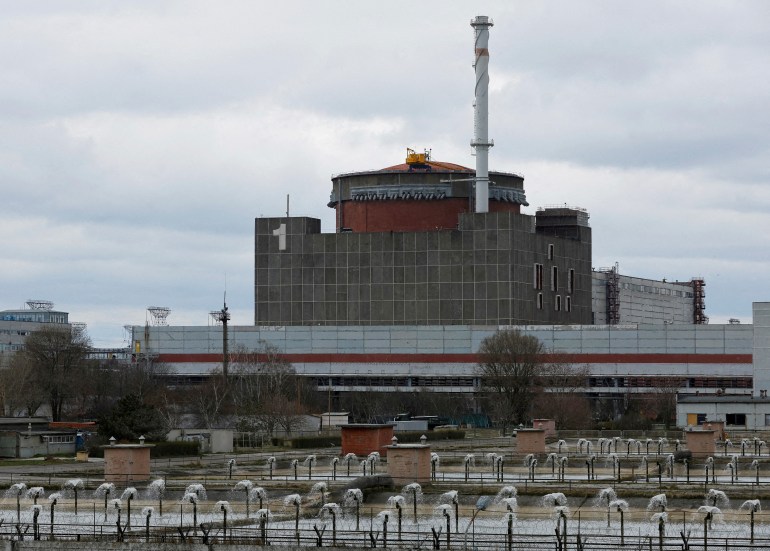A dam and hydroelectric power plant in a Russian-controlled part of southern Ukraine have been destroyed, unleashing a torrent of water and prompting fears of wide-scale flooding in the area downstream on the Dnipro river.
Ukrainian and Russian officials have urged local communities near the Nova Kakhovka dam to evacuate the area immediately.
What happened?
It is unclear what exactly destroyed the dam early on Tuesday, but from the images being broadcast from the scene, it appears that an explosion blew up a large part of the structure.
Videos showed the buildings around the entrance of the dam being heavily damaged, while a large body of water was seen gushing through a hole in the structure.
Who is to blame for destroying the dam?
Ukrainian and Russian officials have accused each other of blowing up the dam, although conflicting reports have emerged from Moscow-installed officials.
Ukrainian President Volodymyr Zelenskyy accused “Russian terrorists” of destroying the dam and said the outrage “confirms for the whole world that they must be expelled from every corner of Ukrainian land”.
“Not a single meter should be left to them, because they use every meter for terror,” he wrote in a tweet. “The terrorists will not be able to stop Ukraine with water, missiles or anything else,” he said.
Andriy Yermak, head of Zelenskyy’s office, also labelled the alleged act “ecocide”.
The world must see and react to the consequences of Russian terrorism against civilian population of Ukraine, as well as ecocide. pic.twitter.com/PKBtLVXuwc
— Andriy Yermak (@AndriyYermak) June 6, 2023
A Moscow-installed official in Nova Kakhovka, Vladimir Leontev, told Russian state television that the damage to the dam was the result of a series of Ukrainian attacks.
However, Vladimir Rogov, a Russian-installed official in Zaporizhzhia, said the dam collapsed due to earlier damage and the pressure of the water.
Who controls Nova Kakhovka dam?
The dam is located in Russian-controlled territory near the major city of Kherson.
Russian forces captured Kherson in March 2022, but a successful Ukrainian counteroffensive retook the city in November 2022, as Russian troops retreated to the southern bank of the Dnipro river.
Russia still controls most of the territory on the southern banks downstream from the dam, while Ukraine controls the territories to the north of the river.
Why is the dam significant?
The dam, 30 metres (98 feet) tall and 3.2km (2 miles) long, was built in 1956 on the Dnipro river as part of the Kakhovka hydroelectric power plant.
It supplies water to large swaths of southeastern Ukraine, as well as the Russian-annexed Crimean peninsula.
The dam’s reservoir also provided water used for the essential cooling of the six reactors at the Zaporizhzhia Nuclear Power Plant (ZNPP), the largest such facility in Europe, as well as for spent fuel and emergency diesel generators that have had to be used repeatedly when external power fails.
What is the threat to the nuclear power plant?
Both sides have made statements to quell fears that the plant is at risk.
Ukraine’s state nuclear power agency, Energoatom, said although the recent events posed a risk to the plant, the situation was “under control”.
For its part, Russia’s state nuclear energy company Rosatom said there was no threat to the ZNPP.

The United Nations nuclear watchdog, the International Atomic Energy Agency (IAEA), said on Twitter it was closely monitoring the situation but that there was “no immediate nuclear safety risk at [the] plant”.
I
The IAEA is aware of reports of damage at #Ukraine’s Kakhovka dam; IAEA experts at #Zaporizhzhya Nuclear Power Plant are closely monitoring the situation; no immediate nuclear safety risk at plant.#ZNPP
— IAEA – International Atomic Energy Agency ⚛️ (@iaeaorg) June 6, 2023
IAEA chief Rafael Grossi said the plant should have enough water to cool its reactors for “some months” from a pond located above the reservoir of the dam
“There are a number of alternative sources of water. A main one is the large cooling pond next to the site that by design is kept above the height of the reservoir,” he said in a statement.
What is the potential ecological effect?
River banks are already flooding as water pours over through the destroyed dam structure.
The exact ecological consequences are yet to be clearly identified, but Ukrainian officials have warned they could be serious.
Yermak wrote, “The Russians will be responsible for the possible deprivation of drinking water for people in the south of Kherson region and in Crimea, the possible destruction of some settlements and the biosphere.”
The Russian-backed governor of Crimea said on Tuesday that there is a risk that water levels in the North Crimean canal, which carries fresh water to the peninsula from the Dnipro river, could fall as a consequence of the dam’s destruction.
The Crimean peninsula is dependent on fresh water from the canal. Ukraine previously blocked water supplies to Crimea after Russia annexed the peninsula in 2014, causing water shortages in the region.
The destruction of the Kakhovka dam today puts thousands of civilians at risk and causes severe environmental damage.
This is an outrageous act, which demonstrates once again the brutality of #Russia’s war in #Ukraine.— Jens Stoltenberg (@jensstoltenberg) June 6, 2023
What has the international reaction been?
NATO’s Secretary General Jens Stoltenberg said the destruction of the dam demonstrated “the brutality of Russia’s war in Ukraine”.
Charles Michel, the president of the European Council, said the act qualifies as a “war crime”.
Shocked by the unprecedented attack of the Nova Kakhovka dam.
The destruction of civilian infrastructure clearly qualifies as a war crime – and we will hold Russia and its proxies accountable.
— Charles Michel (@CharlesMichel) June 6, 2023
British Foreign Secretary James Cleverly said it was too early to give a meaningful assessment of the details behind the destruction of a dam in southern Ukraine but that it had happened because of Russia’s invasion.
















